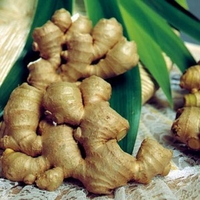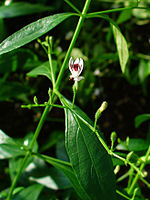Philippine Natural Herbal Remedies, The Oldest Form of Healthcare
These natural herbal remedies have been used by all cultures throughout history. The plants provided food, clothing, shelter, and medicine.
Much of the medicinal use of plants seems to have been developed through observations of wild animals, and by trial and error.
Herbal medicine is the oldest form of healthcare known to mankind, no wonder many drugs known today are of herbal origin. Somehow, as many believe in the potency of herbal medicine to cure ailments, there are also equally many that refute it in favor of scientific medicine.

Ginger Root
Weather and Natural Herbal Remedies
As it is, health and weather conditions complement each other. The Philippine Atmospheric, Geophysical and Astronomical Services Administration (PAGASA) said large parts of the country would get above-normal rainfall in the summer months of March, April and May. Weather conditions have changed so that the Philippine summer has become wet because of the La Nina phenomena. This change in weather poses some health hazards, especially to the respiratory system of people with low immune systems.
Health problems become complicated with unfavorable weather conditions. During this time, some folks cling to the antique, yet very useful natural herbal remedies and the medicinal value of herbs.
Luyang Dilaw Herbal Tea - Natural Herbal Remedies
Wevina Rodriquez of Pagadian City is one of them. As a Community-Based Health Program (CBHP) worker, she learned and relied on the healing properties of luyang dilaw.
In 2000 this knowledge inspired her to produce homemade luyang dilaw tea. Manually, she ground and dried it to come up with a luyang dilaw powder. She mixed it with coffee or milk to quell its pungent smell. Friends and relatives are the happy recipient of the tea as a gift during birthdays and other occasions. But the difficulty in manually producing the tea and her physical condition, forced her to stop production even for family consumption in 2007.
It was at this time that her friends and relatives whom she gave herbal tea, came to her and asked for more of her luyang dilaw tea. Wevina, fondly called Inday, says her friends claim that "their high blood pressure normalized and their immune system boost so that they no longer got sick very often."
Luyang Dilaw, or Ginger Root (scientific name: Zingiber officinale) belongs to the family of Zingiberaceae. The rootstocks of this erect, smooth plant are thick, and have strong aromatic qualities. Its edible roots, tops, and even its leaves are found to have medicinal value. As an herbal medicine, Luyang Dilaw has long been used as a cold, cough, fever, and sore throat remedy.
Ginger helps in the digestion and absorption of food, lowering of cholesterol, alleviating nausea and vomiting. Luyang dilaw has antifungal, antiseptic, antiviral, and anti-inflammatory properties as well. In the same way, it has been found to contain potent anti-oxidant qualities, which come from the extract and active constituents of the plant. These uses are separate and distinct from the nutritional value of luyang dilaw.1
High blood pressure forced Wevina Rodriquez to stop working in the CBHP in 2008. High maintenance of synthetic medicine awakened her senses to go back to the antiquated healing capability of natural herbal remedies. No work and financially broke, she went back to produce the luyang dilaw tea and discarded her maintenance medicines.
This time, her friends came back to her for their supply of luyang dilaw tea which she now sells. In 2009 she registered it at the Department of Science and Technology (DOST-IX) under ZDS (Zamboanga del Sur) Venture. The luyang dilaw tea, has now a variant in capsule packaging.
Other herbal capsules such as extracts from mirabilos Andrographis Paniculata), and guyabano are now available at ZDS Venture.
Andrographis Paniculata - Natural Herbal Remedies
Andrographis paniculata (AP), also known commonly as "King of Bitters," is a member of the plant family Acanthaceae, and has been used for centuries in Asia to treat GI tract and upper respiratory infections, fever, herpes, sore throat, and a variety of other chronic and infectious diseases. It is found in the Indian Pharmacopoeia and is the prominent in at least 26 Ayurvedic formulas; whereas in Traditional Chinese Medicine (TCM), Andrographis is an important "cold property" herb: it is used to rid the body of heat, as in fevers, and to dispel toxins from the body.

King of Bitters - Natural Herbal Remedies
In Scandinavian countries, it is commonly used to prevent and treat common colds. Research conducted in the'80's and'90's has confirmed that Andrographis, properly administered, has a surprisingly broad range of pharmacological effects, some of them extremely beneficial.
King of Bitters Natural Herbal Remedies
Digestive: Promotes digestion - Hepatoprotective: Protects the liver and gall bladder - Vermicidal: Kills intestinal worms & support intestine - Anti-acne: Protect skin from pimples - Analgesic: Pain killer - Anti-inflammatory: Reduces swelling and cuts down exudation from capillaries - Antibacterial: Fights bacterial activity. Although Andrographis appears to have weak direct antibacterial action, it has remarkably beneficial effect in reducing diarrhea and symptoms marising from bacterial infections - Expectorant: Promotes mucus discharge from the respiratory system - Hypoglycemic: Blood sugar reducer - Immune Enhancement - Laxative: Aids bowel elimination - Sedative: A relaxing herb, though not with the same effect as the accepted herbal sedatives, valerian roots, hops, skullcap, etc.2
ANONA MURICATA Linn. GUAYABANO Local names: Atti (Ibn.); babana (P. Bis.); bayubana (Ilk.); gayubano (Ilk., Ibn.); guayabano (Tag.); labanus (Sul.) ilabanos (Bic.); sourso p (Engl.)3
Guyabano/Soursop Fruit Nutrition
Guyabano belongs to the family of Annonaceae, (A. muricata L.). The flesh of the fruit consist of a white edible pulp that is high in carbohydrates and considerable amounts of Vitamin C, Vitamin B1, Vitamin B2, Potassium and dietary fiber. Guyabano is low in cholesterol, saturated fat and sodium. Not only is guyabano a good health food, it also taste delicious.
Guyabano Natural Herbal Remedies
Guyabano has been used as folkloric herbal medicine in many regions thought the world. It is considered to be antispasmodic, sudorific and emetic. A decoction (boiling in water) of guyabano leaves is used to kill bedbugs and head lice.
To reduce fever, a decoction of leaves can be taken internally or the leaves added to bathing water also has the same effect. The crushed fresh leaves are also applied on skin eruptions for faster healing. A poultice of young guyabano leaves is applied on the skin to alleviate rheumatism and other skin infections like eczema. Applied during the healing of wounds, this can result in less or no skin scars. The decoction can also be used as a wet compress on swollen feet and other inflammations.
The juice of the fruit is taken orally as a herbal remedy for urethritis, haematuria and liver ailments.
Studies are underway by leading medical institutes, universities and pharmaceutical companies of the healing properties of guyabano against cancers. Initial findings show that certain compounds and chemicals extracted from guyabano leaves, seeds, fruit and bark appear to kill cancer cells while leaving normal cells unaffected.4
Your Choice - Natural Herbal Remedies
Health is wealth. We ought to take care of it. Going herbal?
Try some of the Philippine natural herbal remedies. The best choice for your long-term health. (PIA9/Noemi Edaga)
Reference:
1) http://www.philippineherbalmedicine.org/ginger.htm
2) http://herbal-powers.com/andrographis.html
3) http://www.bing.com/search?q=anona+muricata&mkt=en-us&FORM=IPGTLB&PC=IPGTDF
4) http://www.philippineherbalmedicine.org/guyabano.htm


